Refreshed and fortified, we embarked on our day's first adventure. Park Güell is one of Barcelona's must-see sites, named for Count Eusebi Güell who owned the 50-acre property and commissioned Antonio Gaudí in 1890 to design a garden city there. The Count was an admirer of the English garden cities that were all the rage at the time (sounds like my kind of guy; and a Count! Wonder if he has any eligible bachelor great-great-great grandsons?), which explains the English spelling of 'park'; in the native Catalan it would be spelled 'parc'. He wanted it to be an exclusive gated community for Barcelona's rich and famous but that dream was never realized. The park was completed between 1910 - 1914 without the intended 60 mansions and opened to the public as a municipal park in 1922.
There are many ways of getting to Park Güell; we chose the most aerobic one. The park sits at the top of a long, steep hill a fair hike from the nearest Metro station. By the time we neared the top we were hot, sweaty, and a detour into a small market for a bottle of water was greeted as the best idea of the day! In Europe, when you ask for water at a cafe you can request tap, still, or sparkling. We had a giggle over the label on a bottle of sparkling water.

Gassed up and ready to go, we reached the top and just a few steps ahead was the park.
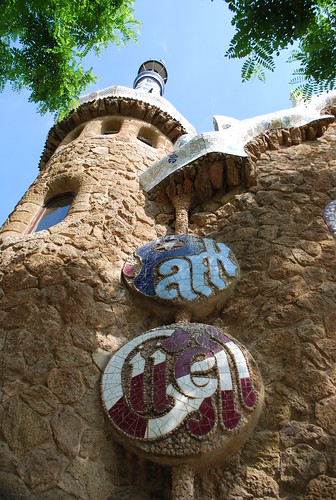
"Nothing is invented; it's written in nature"
Antonio Gaudí (1852 - 1926) was the leading exponent of Catalan Modernism and his most notable works can all be seen in Barcelona. He was inspired by nature and used natural materials such as local stone in his designs. In his youth he served as a blacksmith's apprentice then studied architecture and engineering. As you explore the park, his natural inspirations reveal themselves in the structures he designed. Fluted columns bloom into a concrete canopy, footpaths in stone arcades arch like a surfer's wave to support vehicular roadways above. Patterns, textures, colors all mimic the natural landscape. The result is one of the most intriguing municpal parks in the world.
This alcove at the main entrance provided a sanctuary from the hot summer sun for the musician playing there.
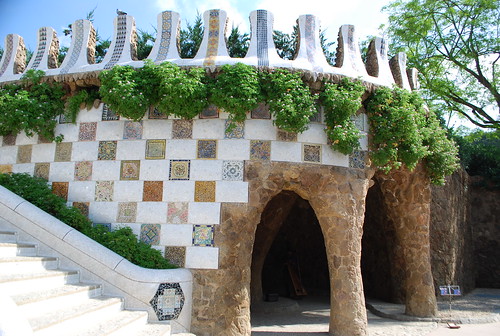

The wall of the alcove is covered in these intricate and vibrant tile mosaics.

Up the main steps is this tiled drooling dragon (or lizard, if you're not into the medieval legends that Gaudí enjoyed), covered in ceramic and glass mosaic.
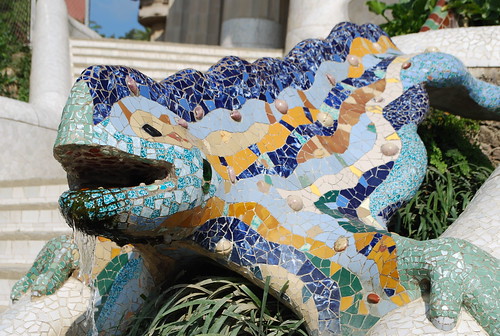
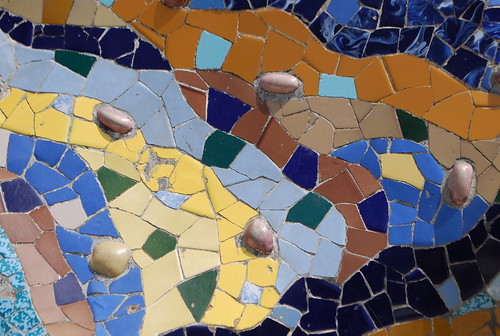
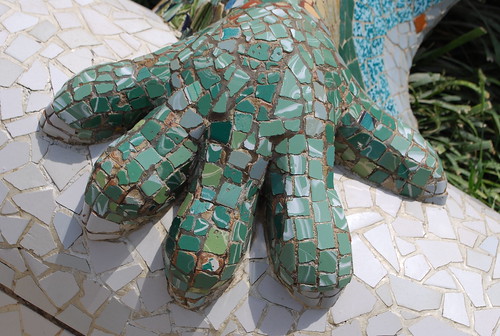 At the top of the steps is the Hall of a Hundred Columns which rise like a concrete forest to support the Gran Plaça Circular - the main terrace - above. After the hot climb up that hill, the Hall provided a cool and welcome respite. Musicians played throughout the park, and the acoustics in the Hall were so good that you could hear the guitar player just as well standing behind him as you could standing in front of him. My buddy Nate and I enjoyed the music sitting on the rear stairs, resting in the cool shade, soaking in the sights and sounds.
At the top of the steps is the Hall of a Hundred Columns which rise like a concrete forest to support the Gran Plaça Circular - the main terrace - above. After the hot climb up that hill, the Hall provided a cool and welcome respite. Musicians played throughout the park, and the acoustics in the Hall were so good that you could hear the guitar player just as well standing behind him as you could standing in front of him. My buddy Nate and I enjoyed the music sitting on the rear stairs, resting in the cool shade, soaking in the sights and sounds. 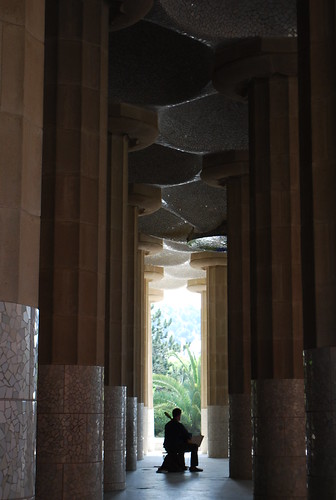 The ceiling of the Hall reminded me of an inverted egg carton with colorful mosaic medallions. It was an appropriate comparison, as the Hall was originally intended to be the housing community's central market, where the sellers and their wares would be protected from the elements.
The ceiling of the Hall reminded me of an inverted egg carton with colorful mosaic medallions. It was an appropriate comparison, as the Hall was originally intended to be the housing community's central market, where the sellers and their wares would be protected from the elements.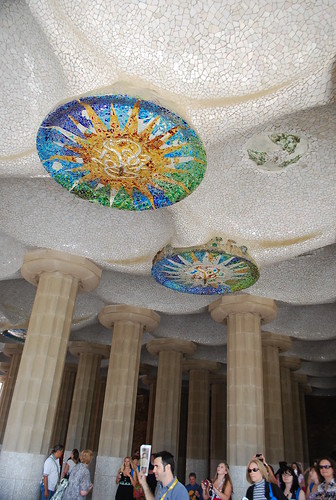
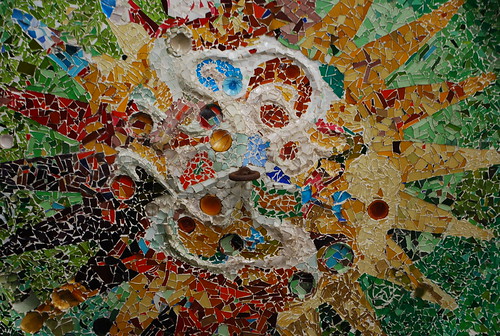
 Gaudí 's training as a blacksmith translated into intricate designs in metalwork.
Gaudí 's training as a blacksmith translated into intricate designs in metalwork.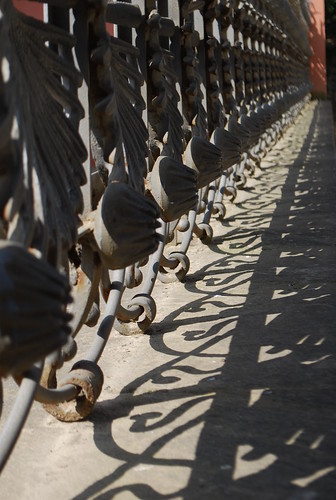 A winding stone staircase leads to the main plaza above the Hall. The wall is studded with these yawning lion's heads, part of the ingenious water catchment system that Gaudí designed. Originally, rain that hit the main terrace was directed to and through the stone columns below where it would feed and power the fountains. Given that the average annual rainfall in Barcelona is only about 23 inches, I don't think the fountains would have been terribly lively.
A winding stone staircase leads to the main plaza above the Hall. The wall is studded with these yawning lion's heads, part of the ingenious water catchment system that Gaudí designed. Originally, rain that hit the main terrace was directed to and through the stone columns below where it would feed and power the fountains. Given that the average annual rainfall in Barcelona is only about 23 inches, I don't think the fountains would have been terribly lively. Directly above the Hall is the Gran Plaça Circular. The view of Barcelona from here is stunning (the slight haze of smog along with the Agaves, Bougainvillea, and Cypress trees felt oddly familiar!). Encircling the plaza like a ceramic beaded necklace is a serpentine bench reputed to be the longest bench in the world. The curves in the bench create cozy alcoves. Supposedly when Gaudí was designing the bench seats he created a mold by parking a worker and his naked buttocks on a block of wet clay.
Directly above the Hall is the Gran Plaça Circular. The view of Barcelona from here is stunning (the slight haze of smog along with the Agaves, Bougainvillea, and Cypress trees felt oddly familiar!). Encircling the plaza like a ceramic beaded necklace is a serpentine bench reputed to be the longest bench in the world. The curves in the bench create cozy alcoves. Supposedly when Gaudí was designing the bench seats he created a mold by parking a worker and his naked buttocks on a block of wet clay.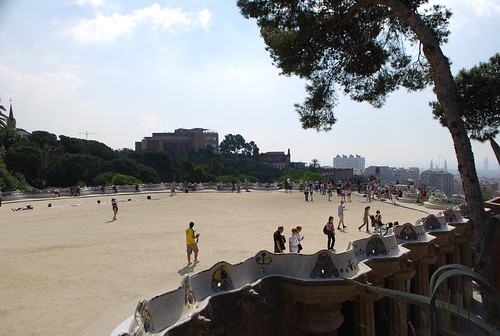
Since the park was intended to be an exclusive community, a model home was built but no buyers presented themselves so the house was put on the market in 1906. At the advice of his patron, Gaudí bought the house and moved his family to the Park where they lived until his father died in 1925. Now the house is a museum.
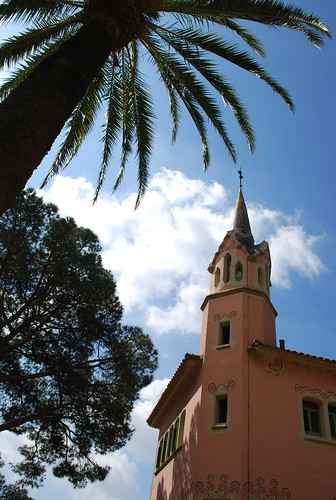 I don't know if it was intentional, but the the trails and footpaths were designed so that they lure you in and guide you around curves to surprises at the other end. Interrupting your journey down this path to a dead end was a massive and ancient tree trunk, worn smooth and shiny by countless years of caresses by weather and humans.
I don't know if it was intentional, but the the trails and footpaths were designed so that they lure you in and guide you around curves to surprises at the other end. Interrupting your journey down this path to a dead end was a massive and ancient tree trunk, worn smooth and shiny by countless years of caresses by weather and humans.
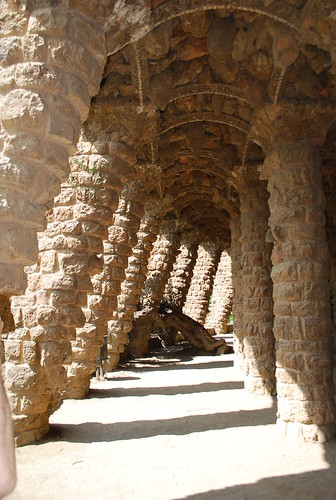
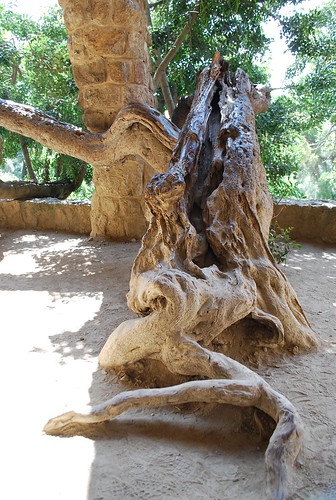 The plants at Park Güell were wildly reminiscent of those I knew in So Cal. Between the weather, the topography, and the plant material I felt as if I could have been back in LA. As interesting as Griffith Park in LA is, it would be so much better with more spaces like the ones at Park Güell. The view probably wouldn't be as good, though, since you often can't observe downtown LA from Griffith Observatory due to the amount of smog.
The plants at Park Güell were wildly reminiscent of those I knew in So Cal. Between the weather, the topography, and the plant material I felt as if I could have been back in LA. As interesting as Griffith Park in LA is, it would be so much better with more spaces like the ones at Park Güell. The view probably wouldn't be as good, though, since you often can't observe downtown LA from Griffith Observatory due to the amount of smog.
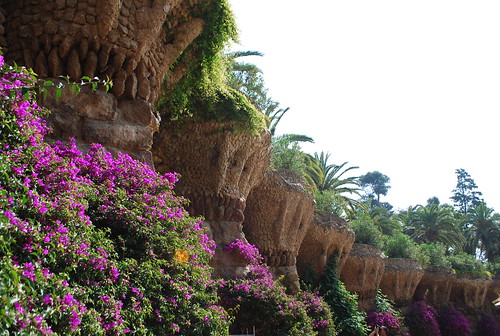 For an even better view of Barcelona, trek up the hill to las tres cruces. There is no guard rail on the narrow stair, so hug the center as you ascend, and especially when descending! From the top, you and 30 of your newest friends will have a 360-degree panoramic view of the city.
For an even better view of Barcelona, trek up the hill to las tres cruces. There is no guard rail on the narrow stair, so hug the center as you ascend, and especially when descending! From the top, you and 30 of your newest friends will have a 360-degree panoramic view of the city.


 Park Güell is one place I will definitely return to, hopefully with much more time to wander and even more time to linger. If you're Barcelona bound, this is one place you just have to see for yourself! Go early to beat the crowds, gas up with a bottle of cold, bubbly agua and enjoy a taste of local life. Stay tuned for another post on Gaudí's unfinished master work, La Sagrada Familia.
Park Güell is one place I will definitely return to, hopefully with much more time to wander and even more time to linger. If you're Barcelona bound, this is one place you just have to see for yourself! Go early to beat the crowds, gas up with a bottle of cold, bubbly agua and enjoy a taste of local life. Stay tuned for another post on Gaudí's unfinished master work, La Sagrada Familia.




 For an even better view of Barcelona, trek up the hill to las tres cruces. There is no guard rail on the narrow stair, so hug the center as you ascend, and especially when descending! From the top, you and 30 of your newest friends will have a 360-degree panoramic view of the city.
For an even better view of Barcelona, trek up the hill to las tres cruces. There is no guard rail on the narrow stair, so hug the center as you ascend, and especially when descending! From the top, you and 30 of your newest friends will have a 360-degree panoramic view of the city.

 Park Güell is one place I will definitely return to, hopefully with much more time to wander and even more time to linger. If you're Barcelona bound, this is one place you just have to see for yourself! Go early to beat the crowds, gas up with a bottle of cold, bubbly agua and enjoy a taste of local life. Stay tuned for another post on Gaudí's unfinished master work, La Sagrada Familia.
Park Güell is one place I will definitely return to, hopefully with much more time to wander and even more time to linger. If you're Barcelona bound, this is one place you just have to see for yourself! Go early to beat the crowds, gas up with a bottle of cold, bubbly agua and enjoy a taste of local life. Stay tuned for another post on Gaudí's unfinished master work, La Sagrada Familia.





No comments:
Post a Comment